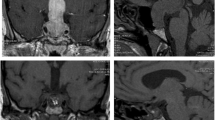Summary
Based on 880 pituitary adenomas operated upon between 1972 and 1982 the diagnostic and therapeutical strategy in recurrences is discussed. The incidence of reoperations was 7.75%, 3.7% in hormonally inactive and 4.1% in hormonally active recurrences. The rate was 30% after transcranial surgery — due to the extension of the tumours — and 5% after the trans-sphenoidal approach.
In hormone inactive adenomas visual impairment in 29 out of 50 recurrences caused a second operation combined with radiotherapy in 13 cases. Radiotherapy alone was used in 17 cases.
In hormonally active adenomas the treatment of persistent hormonal excess represents the main therapeutical problem. With HGH-producing adenomas a return to normal was achieved in 22 cases mainly by a combination of reoperation and radiotherapy (12) or radiotherapy (8) alone. Radiotherapy should be avoided in young patients whenever possible. The procedure of choice in PRL-procuding adenomas (14 cases) seems to be treatment with dopamineagonists (9). An additional reoperation was necessary in five cases.
Similar content being viewed by others
References
Burian, K., G. Pendl, S. Salah: Über die Rezidivhäufigkeit von Hypophysenadenomen nach transfrontaler, transsphenoidaler oder zweiseitig kombinierter Operation. Med. Wochenschr. (Wien) 120 (47) (1971) 833–836
Clark, K.: Surgery for the recurrent pituitary adenoma. Clin. Neurosurg. 27 (1980) 390–314
Collins, W.F.: Management of pituitary tumors. In: Tindall, G. T., W. F. Collins (eds.): Clinical management of pituitary disorders, pp. 343–352. Raven Press, New York 1979
Faglia, G., M. Giovanelli: Pituitary Microadenomas. Mac Leod Academic Press, New York 1980
Fahlbusch, R., K. v. Werder (eds.): Treatment of pituitary adenomas. Thieme Verlag, Stuttgart 1978
Fahlbusch, R., F. Marguth: Tumoren der Hypophyse. In: Dietz, H., W. Umbach, R. Willenweber (eds.): Klinische Neurochirurgie Bd. II, pp. 86–106. Thieme Verlag, Stuttgart 1984
Hardy J. Le prolactinome. Neurochirurgie 27, Suppl. 1 (1981) 41–60
Landolt, A. M.: Praktische Bedeutung neuer Erkenntnisse über Struktur und Funktion von Hypophy-senadenomen. Med. Wochenschr. (Schweiz) 108/40 (1978) 1521–1535
Quabbe, H. J.: Treatment and results in 235 patients with acromegaly. Acta Endocrinol. (Copenh.) Suppl. 240 (1981) 66–67
Saeger, W.: Die Hypophysentumoren. In: Gungeler, W., M. Eder, K. Lenner, G. Peters, W. Sandritter, G. Seifert: Pathologie, Heft 107, Gustav Fischer Verlag, Stuttgart 1977
Salmi, J., B. Grahne, S. Valtonen, R. Pelkonen: Recurrence of chromophobe pituitary adenomas after operation and postoperative radiotherapy. Acta Neurol. (Scand) 66/6 (1982) 681–689
Sheline, G. E.: Pituitary tumors: Radiation therapy. In: Beardwell, C., G. L. Robertson (eds.): The pituitary, pp. 106–139. Butterworth, London 1981
Author information
Authors and Affiliations
Rights and permissions
About this article
Cite this article
Marguth, F., Oeckler, R. Recurrent pituitary adenomas. Neurosurg. Rev. 8, 221–224 (1985). https://doi.org/10.1007/BF01815446
Issue Date:
DOI: https://doi.org/10.1007/BF01815446




